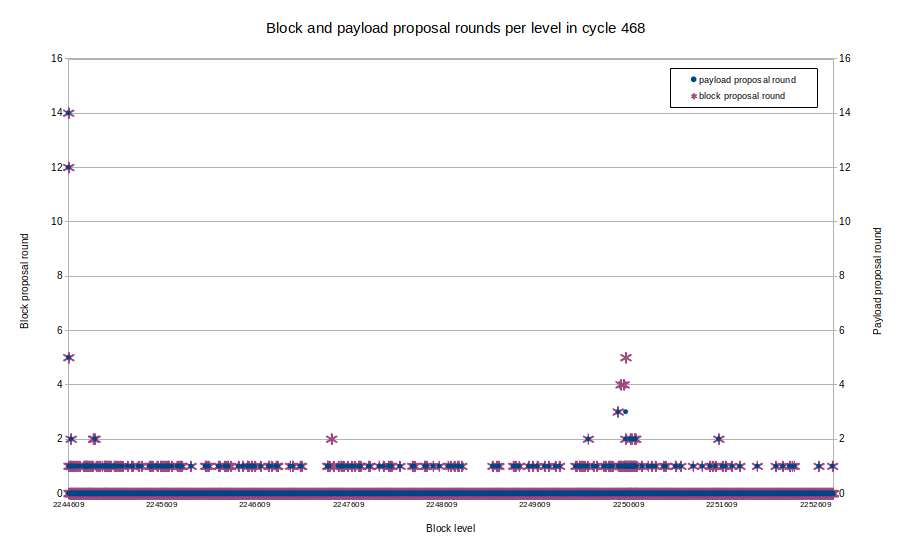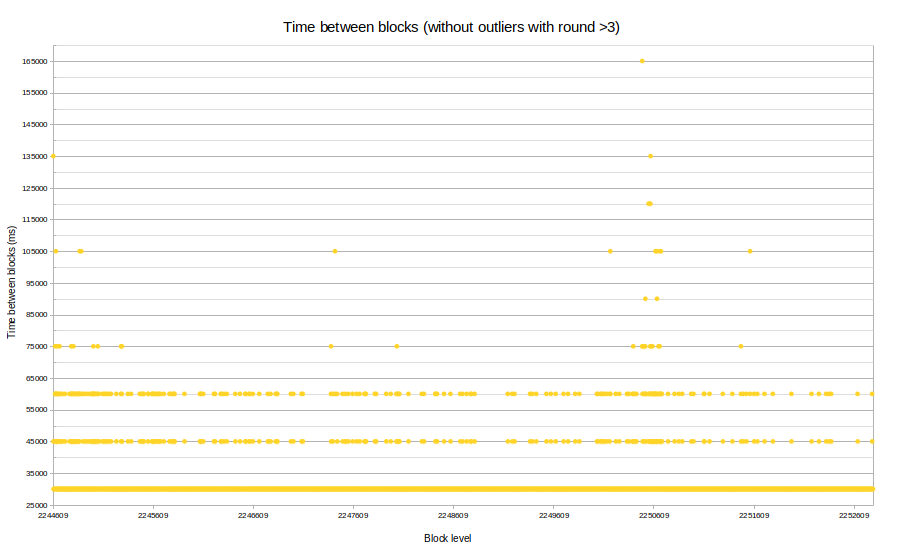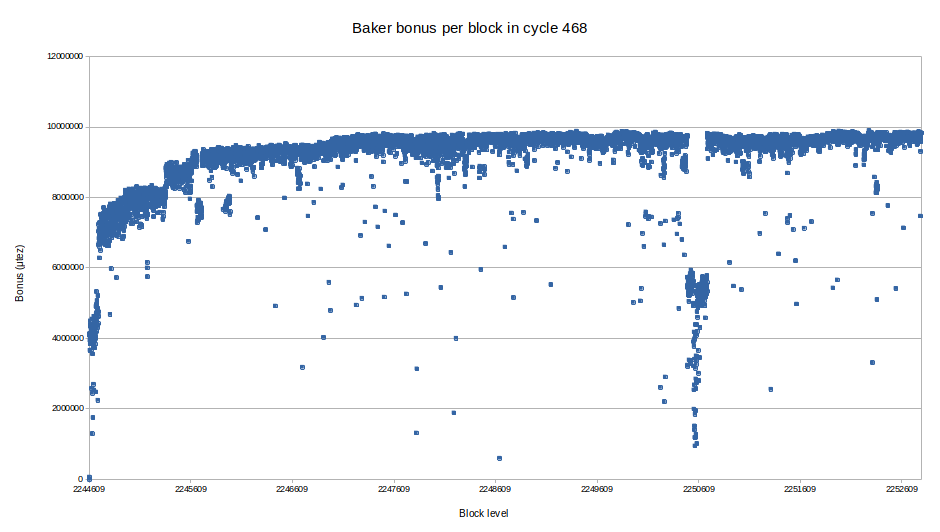This is a joint post with Nomadic Labs.
On April 1st, 2022, the Tezos blockchain successfully executed its
most ambitious protocol upgrade to date. At block
#2,244,609, the
Ithaca2
protocol upgrade was activated on Tezos mainnet, moving the Tezos
network away from the
Emmy
family of consensus algorithms to
Tenderbake.
It is not the first time we have made changes to the consensus
algorithm via the on-chain amendment process, but this time we have
collectively gone where nobody in this space has gone before:
hot-swapping to a completely different consensus algorithm on a live
network without a hard-fork in just 1815 seconds.
Yes, it took only ~30 minutes for a majority of the network
participants to surf the migration waters, get the first block
endorsed by 2/3 of the network, and deliver Odysseus home to Ithaca.
We have been monitoring the network closely since then, and we are
glad to see that the transition from Emmy* to Tenderbake was generally
frictionless, and that the new consensus algorithm is running without
interruptions since the first block of the cycle.
In this article, we present some early observations and reflections on
the behavior of the network during cycle
468 - that is, the first 8192 blocks
of the Ithaca2 protocol, between Friday evening and Monday evening
(Paris time).
The data for this article was retrieved from the TzKT
API.
Say hello to fast deterministic finality!
The following table discriminates the first 8192 blocks of cycle 468,
from the activation of Ithaca2 on block
#2,244,609 until block
#2,244,609 on CEST Monday, April 4th.
 Table 1: Cycle 468 statistics by block round
Table 1: Cycle 468 statistics by block round
Consensus on the head of the chain was both safe and fast: the
average time between blocks was 32.058s, close to the theoretical
minimum of 30 seconds. This is a direct consequence of having an
overwhelming majority of blocks proposed and agreed upon in round 0:
7936 blocks out of 8192 – around 97% of them.
The round
number for a
block denotes the number of attempts (minus one) that were necessary
to reach a consensus on a block at a given level. Lower is better, and
a high number of rounds indicates a slow or unreliable network. Under
normal network conditions, the chain should reach a consensus about
the next block in round 0 – that is, on the first attempt.
Of the remaining 256 blocks, 236 were produced on round 1, 11 on round
2, and 5 blocks in rounds between 3 and 5. The only two outliers were
understandably the first two blocks of the protocol migration, which
passed respectively on rounds 14 and 12. The latter were, also
understandably, the slower blocks of the cycle, with a time between
blocks of 1815s **and **1590s.
These facts are better illustrated observing the values for these
attributes throughout the whole cycle. Figure 2 plots, for
each blockchain level, the payload and block rounds. Further
below, Figure 3 plots the time between blocks without
outliers above round 3[^nicely].
Otherwise, it does not plot nicely, and we cannot distinguish
between blocks on rounds 0, 1, and 2.
 Figure 2: Block and payload proposal rounds per level in cycle 468
Figure 2: Block and payload proposal rounds per level in cycle 468
With Tenderbake, we distinguish between the payload producer and the
block proposer. The payload is the non-consensus content of a block
(transfers, smart contract calls, etc.), and it can
be
locked even if there was no consensus reached at the round. A baker
with rights to propose a block on a higher round must then re-use the
same payload – in jargon, it can re-propose the payload. Thus the
payload round is the round at which the block’s payload has been
first proposed (at the current level), and it is smaller or equal to
the block round.
In the majority of cases, the payload and block rounds match, even for
blocks proposed at rounds higher than 0. Even when Tenderbake splits
baking
rewards
(awarding 10 ꜩ to the payload producer and a variable bonus to the
block producer), in practice, most blocks in the cycle have the whole
of the baking rewards allocated to the same baker. This also
illustrates that even for higher rounds, the payload was first
proposed at the same round as that of the block that was finalized,
entailing that the failure to achieve a quorum on the first round was
more likely to be caused by absent bakers in the committee, rather
than a slow or untimely propagation of preendorsements.
 Figure 3: Time between blocks per level in cycle 468
Figure 3: Time between blocks per level in cycle 468
As we mentioned above, the average time between blocks was
32.058s, pushed downwards by the majority of round 0 blocks. For
round 1 blocks, it was 62.521s, or a bit over a minute. In the
second graph, we also observe a significant minority of blocks with a
45s time between blocks. This corresponds to round 0 blocks which
follow a round 1 block, as the time between
blocks
measures the difference between two consecutive blocks’ timestamps,
and the timestamps are set at the beginning of the round. Thus, the
difference in such cases matches the length of the duration of round 1
– exactly 45s. These corner cases also explain why the average values
for the time between blocks at a given round presented in the table
above, e.g., for round 0, diverge slightly from the theoretical
minima. It moreover explains the maximal outliers, e.g., the 90s
time between blocks for #2,250,528. The
latter is a round 0 block which follows a round 4 predecessor,
#2,250,527.
A safe network means higher bonuses
Starting with Tenderbake, a part of the baking rewards of up to 10
ꜩis paid to the
baker
for having included in a block extra endorsements for its predecessor
resulting in more than the minimal 4667 endorsements slots. That is,
beyond the 2/3rds of the total validations required to keep the chain
live. On average, the blocks in the first cycle had 6795.5 endorsed
slots out of 7000 -- or a 97%. This not only resulted in the majority
of fast round 0 blocks we described before, but was also reflected in
the bonus rewards paid to the bakers: the average bonus included in
each block was 9.125202 tez.
Figure 4 plots the distribution of bonus baking rewards for
each level of cycle 468: the first few blocks included lower bonuses,
as the network was still recovering from the protocol migration and
some bakers were catching up. In fact, the bonus rewards averaged
4.227153 tez in the first 100 blocks, but then we see how it rose
quickly to stabilize over 8 ꜩ by the 1000th block. Past the
quarter-cycle mark, it settled over 9 ꜩ. In fact, the average bonus
rewards for the trailing three-quarters of the cycle was 9.379600
ꜩ.
 Figure 4: Bonus rewards awarded per level in cycle 468
Figure 4: Bonus rewards awarded per level in cycle 468
Notice that around level
#2250609, we can observe a
noticeable drop in the bonus reward: this is consistent with a large
drop in validation power due to a top public baker with a significant
stake being out temporarily. This highlights the fact that given that
Tenderbake favors safety over liveness, ensuring that the network
is live -- and that everybody reaps the rewards -- relies more than
ever on the collective effort.
The sweeping crew is still working
In the days following the activation, a few bakers using Ledger
signers have been reporting issues with their baker software: the
Ledger seems to either occasionally freeze and disconnect when signing
(pre)endorsements, or return parsing errors when signing operations or
blocks.
These can cause the baking daemon to freeze for up to ~10 minutes,
resulting in endorsement misses and occasionally lost baking
slots. This is happening seldomly, and we estimate it will not affect
the participation of the affected bakers enough to make them miss the
full endorsement rewards for the cycle. Sadly, this is not the case
for the occasional blocks lost.
We have been keeping busy with these (and other minor
issues),
which should be fully addressed by an upcoming release of the Ledger
Tezos baking app.
I am hooked on Tenderbake, give me more to read
Along the ride to deliver Tenderbake to Tezos, we have produced and
shared reports on the development of Tenderbake and its features. If
you want to read more about Tenderbake, we leave you a few good reads:
several blog entries;
a few academic articles;
- L. Aştefănoaei, P. Chambart, A. Del Pozzo, T. Rieutord, S. Tucci, E. Zălinescu. Tenderbake -- A Solution to Dynamic Repeated Consensus for Blockchains. In 4th International Symposium on Foundations and Applications of Blockchain (SCFAB) 2021.
- S. Conchon, A. Korneva, M. Iguernlala, A. Mebsout, C. Bozman. Formally Documenting Tenderbake. In 3rd Workshop on Formal Methods for Blockchains (FMBC‘21), July 2021.
and, of course, the main documentation entry-point:
Lessons and looking ahead
The activation of the Ithaca2 protocol marks the end of a
two-years-plus-long journey undertaken by the research and development
teams of Nomadic Labs, Functori, Tweag, and other Tezos core
developers and academic partners, like CEA List and Université
Paris-Saclay.
The superlative performance of Tenderbake so far is also a consequence
of the preparedness of the community. A large majority of bakers were
ready for Tenderbake, and had done their homework in time. We are also
thankful to the many community members that helped out spreading the
word, and were ready to help others in different spaces. After all,
this is a decentralized, collective effort.
Tenderbake is alive and Odysseus is finally home on Ithaca, but it
does not mean we are done. We have ambitious
plans
for the future of the Tezos blockchain, and the performance of the
early Tenderbake cycles gives us confidence to keep pushing the
boundaries.
Sails are going to be raised back up soon.
Fair winds!